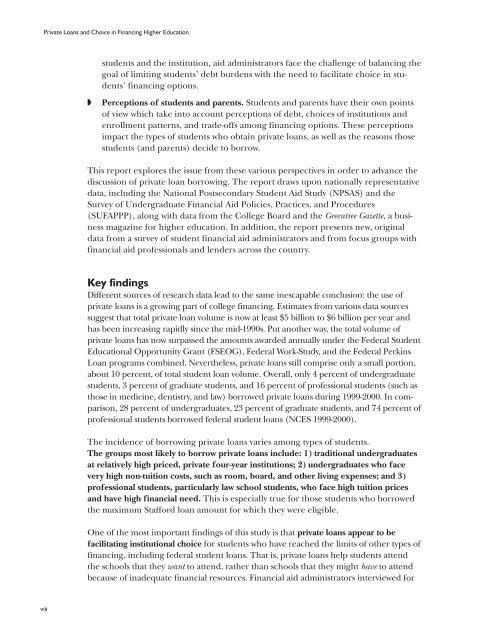Private Loans and Choice in Financing Higher Education - College ...
Private Loans and Choice in Financing Higher Education - College ...
Private Loans and Choice in Financing Higher Education - College ...
Create successful ePaper yourself
Turn your PDF publications into a flip-book with our unique Google optimized e-Paper software.
<strong>Private</strong> <strong>Loans</strong> <strong>and</strong> <strong>Choice</strong> <strong>in</strong> F<strong>in</strong>anc<strong>in</strong>g <strong>Higher</strong> <strong>Education</strong>students <strong>and</strong> the <strong>in</strong>stitution, aid adm<strong>in</strong>istrators face the challenge of balanc<strong>in</strong>g thegoal of limit<strong>in</strong>g students’ debt burdens with the need to facilitate choice <strong>in</strong> students’f<strong>in</strong>anc<strong>in</strong>g options.◗Perceptions of students <strong>and</strong> parents. Students <strong>and</strong> parents have their own po<strong>in</strong>tsof view which take <strong>in</strong>to account perceptions of debt, choices of <strong>in</strong>stitutions <strong>and</strong>enrollment patterns, <strong>and</strong> trade-offs among f<strong>in</strong>anc<strong>in</strong>g options. These perceptionsimpact the types of students who obta<strong>in</strong> private loans, as well as the reasons thosestudents (<strong>and</strong> parents) decide to borrow.This report explores the issue from these various perspectives <strong>in</strong> order to advance thediscussion of private loan borrow<strong>in</strong>g. The report draws upon nationally representativedata, <strong>in</strong>clud<strong>in</strong>g the National Postsecondary Student Aid Study (NPSAS) <strong>and</strong> theSurvey of Undergraduate F<strong>in</strong>ancial Aid Policies, Practices, <strong>and</strong> Procedures(SUFAPPP), along with data from the <strong>College</strong> Board <strong>and</strong> the Greentree Gazette, a bus<strong>in</strong>essmagaz<strong>in</strong>e for higher education. In addition, the report presents new, orig<strong>in</strong>aldata from a survey of student f<strong>in</strong>ancial aid adm<strong>in</strong>istrators <strong>and</strong> from focus groups withf<strong>in</strong>ancial aid professionals <strong>and</strong> lenders across the country.Key f<strong>in</strong>d<strong>in</strong>gsDifferent sources of research data lead to the same <strong>in</strong>escapable conclusion: the use ofprivate loans is a grow<strong>in</strong>g part of college f<strong>in</strong>anc<strong>in</strong>g. Estimates from various data sourcessuggest that total private loan volume is now at least $5 billion to $6 billion per year <strong>and</strong>has been <strong>in</strong>creas<strong>in</strong>g rapidly s<strong>in</strong>ce the mid-1990s. Put another way, the total volume ofprivate loans has now surpassed the amounts awarded annually under the Federal Student<strong>Education</strong>al Opportunity Grant (FSEOG), Federal Work-Study, <strong>and</strong> the Federal Perk<strong>in</strong>sLoan programs comb<strong>in</strong>ed. Nevertheless, private loans still comprise only a small portion,about 10 percent, of total student loan volume. Overall, only 4 percent of undergraduatestudents, 3 percent of graduate students, <strong>and</strong> 16 percent of professional students (such asthose <strong>in</strong> medic<strong>in</strong>e, dentistry, <strong>and</strong> law) borrowed private loans dur<strong>in</strong>g 1999-2000. In comparison,28 percent of undergraduates, 23 percent of graduate students, <strong>and</strong> 74 percent ofprofessional students borrowed federal student loans (NCES 1999-2000).The <strong>in</strong>cidence of borrow<strong>in</strong>g private loans varies among types of students.The groups most likely to borrow private loans <strong>in</strong>clude: 1) traditional undergraduatesat relatively high priced, private four-year <strong>in</strong>stitutions; 2) undergraduates who facevery high non-tuition costs, such as room, board, <strong>and</strong> other liv<strong>in</strong>g expenses; <strong>and</strong> 3)professional students, particularly law school students, who face high tuition prices<strong>and</strong> have high f<strong>in</strong>ancial need. This is especially true for those students who borrowedthe maximum Stafford loan amount for which they were eligible.One of the most important f<strong>in</strong>d<strong>in</strong>gs of this study is that private loans appear to befacilitat<strong>in</strong>g <strong>in</strong>stitutional choice for students who have reached the limits of other types off<strong>in</strong>anc<strong>in</strong>g, <strong>in</strong>clud<strong>in</strong>g federal student loans. That is, private loans help students attendthe schools that they want to attend, rather than schools that they might have to attendbecause of <strong>in</strong>adequate f<strong>in</strong>ancial resources. F<strong>in</strong>ancial aid adm<strong>in</strong>istrators <strong>in</strong>terviewed forviii
















